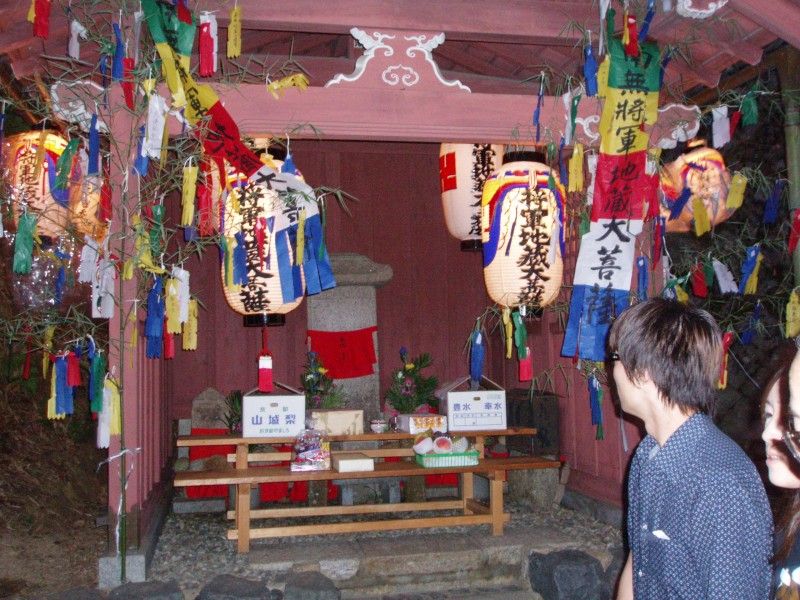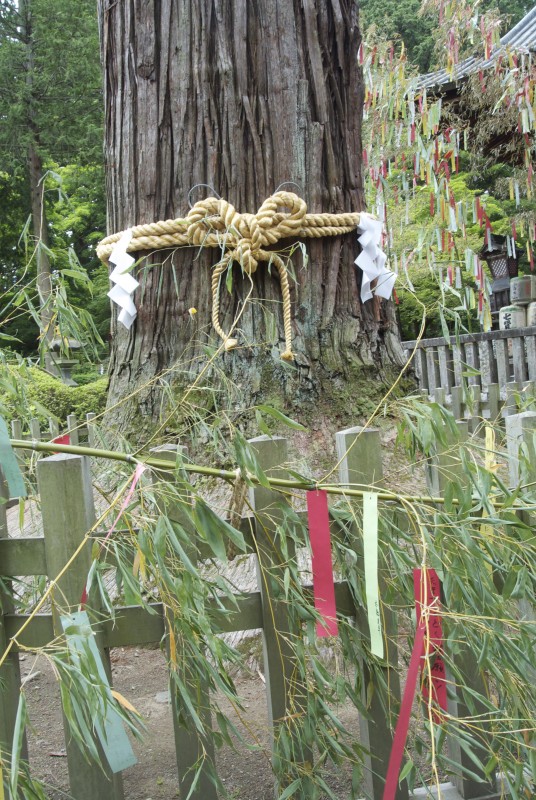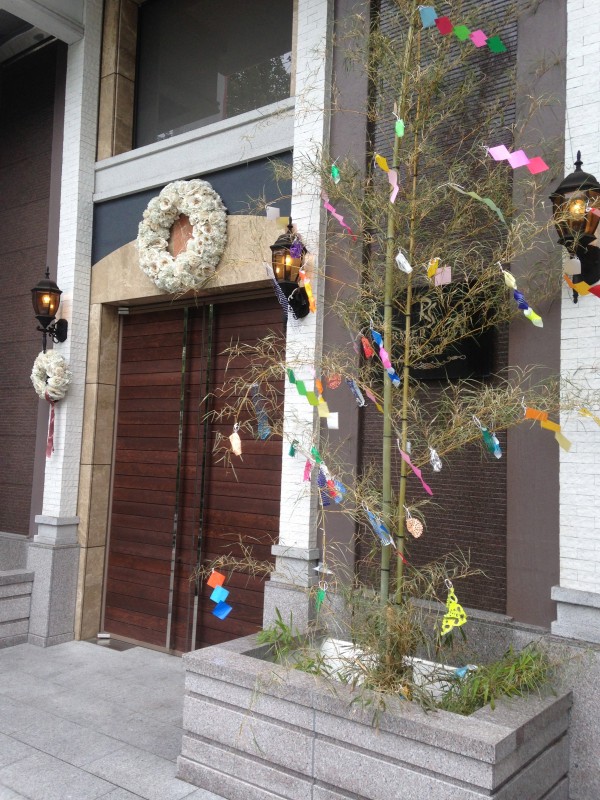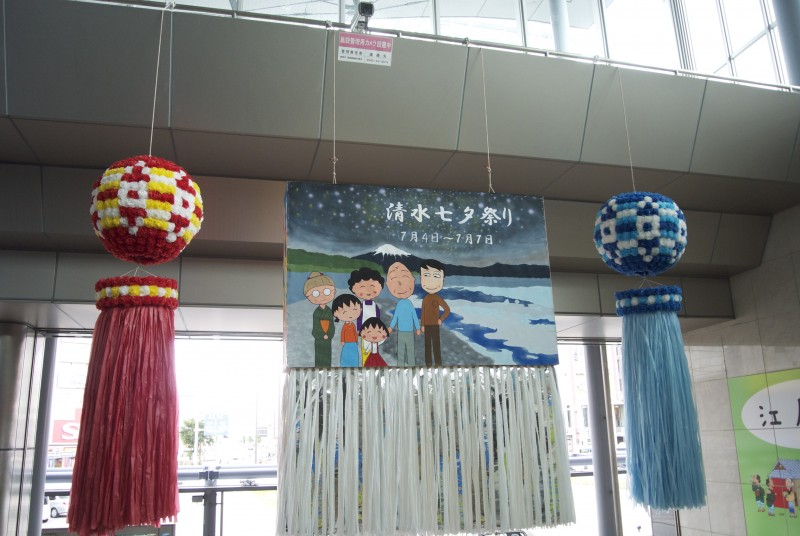 7/7 (July 7) might be considered lucky indeed. And in Japan it’s closely associated with stars and lovers. How come?
7/7 (July 7) might be considered lucky indeed. And in Japan it’s closely associated with stars and lovers. How come?
Stars and constellations had a close connection with the spirituality of early Man. ‘It’s written in the stars,’ goes the old saying. Tanabata is a clear example. It concerns two lovers represented by two different constellations, which are separated by the Milky Way but able to meet once a year. By way of celebration, people write poems or their wishes on strips of brightly coloured paper which are tied to bamboo.
Like much of ‘Japanese tradition’, it has its origins in China. It was first mentioned in the 7th century, and later during the Tokugawa period it became established as one of the ‘five seasonal feasts’. These included New Year’s Day (1/1); Kyokusui no en (Poetry writing) (3/3); Boys Festival (5/5); and the Festival of Chrysanthemums (9/9). Things have changed since then, but the Tanabata tradition carries on. (Why is there no 11/11 festival? Because the Chinese number system was thought to end with 9.)

Tanabata decorations around a sacred tree
Here is what the authoritative Kokugakuin encyclopedia has to say on Tanabata:
“According to an ancient Chinese story, two lovers—the Herdsman (Altair in the constellation Aquila) and the Weaver woman (Vega in the constellation Lyra)—traversed the sky separately and could cross the Milky Way and be together but once a year provided the sky was clear. This day was called Qi Xi, or “seventh night” (read tanabata in Japanese).
A similar myth existed in Japan about the saintly maiden weaver, Tanabatatsume (lit. ‘girl of the shelved loom’), who awaits her annual one-night visit from a kami at her hut by the river (that is, the Milky Way), and this fused with the Chinese tale of the Weaver woman.
Also related to this celebration is a festival called kikōden, during which women pray for improvement in their weaving and calligraphy skills. At the court during the Heian period, they would skewer various foods from land and sea such as pears, peaches, and dried bream on seven gold and seven silver needles and threading them with five-colored string (blue, yellow, red, white, and black) to use as a tanabata offering. A banquet would also be held during which the emperor would observe the meeting of the stars, and performances of poetry, songs, and instrumental music would take place.

Tanabata decorations at a Kyoto wedding hall
Nowadays on Tanabata, people commonly write poems or wishes on fancy strips of paper (tanzaku) and cut stars and other shapes out of brightly colored paper, and use these to decorate a stalk of bamboo. The decorated stalks are customarily released into rivers, streams, and the sea the next morning. Some believe this practice is the product of the spread of lessons in reading and writing during the Edo period.
In some areas, horse-shaped puppets or other objects are substituted for bamboo stalks, and in others, the celebration involves a lighting of torches. Regardless of these variations, the celebrations that mark Tanabata are another example of an event wherein people welcome the kami and their ancestors for the occasion and send them away after they have spent the night.”
***************************************************
Wikipedia also carries a full page of information on Tanabata, including this rather interesting titbit…
In 2008, the 34th G8 summit in Tōyako, Hokkaidō coincided with Tanabata. As host, Japanese Prime Minister Yasuo Fukuda invited the G8 leaders to participate in the spirit of the festival. They were each asked to write a wish on a piece of paper called tanzaku, to hang the tanzaku on a bamboo tree, and then to take the necessary actions to change the world for better. As a symbolic gesture, the actual writing and the act of hanging up that note is at least a first step.
The Japanese Ministry of Foreign Affairs made colored strips of paper and a bamboo tree for G8 wishes available in Roppongi during the summit. Protesting organizations in Sapporo during the G8 summit also tried to use the spirit of Tanabata to focus attention on a somewhat different set of wishes. Non-governmental organizations like Oxfam, and CARE International set up an online wish petition campaign to coincide with the G8 Summit and Tanabata.

Decorations to advertise the Iwashimizu Tanabata Festival

Excellent summary on the interesting features of this holiday. Tanabata is such a pleasant festival that they have one in July and again in August. (old calendar/ new calendar issues) Kyoto holds an annual Tanabata festival along Horikawa Street during the first week of August.
Just wanted to point out that the first festival of the year is actually this one:
7th day of the 1st Month: 人日 (Jinjitsu), 七草の節句 (Nanakusa no sekku) held on 7th of January
Thanks for that… First time I’ve come across the idea of Jan 7th being aligned with 3/3, 5/5. 7/7, 9/9. Something definitely doesn’t seem right about it…
I was privileged to participate in a Star Festival celebration at Kumano Shrine in Kanagawa Prefecture on July 5th in the lead up to the main event on 7/7. The Shrine grounds were full of people of all ages enjoying the festive spirit. Because of the rain, the taiko and Gagaku performances associated with the event were held inside in front of the main shrine. As guests of the shrine, we had front row seats. It was an amazing evening.